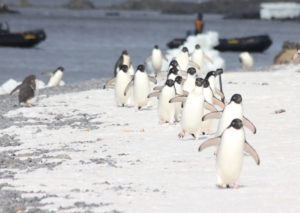
Saving Penguins with AI

Penguin populations (like those of most adorable animals) are threatened by looming environmental catastrophes, including climate change – but, as in the case of whales, protecting those populations first requires that we understand them and the challenges they are encountering. Now, Intel and Gramener are highlighting new research that uses AI to analyze Antarctic penguin populations, paving the way for better protection of their fragile ecosystem.
Gramener, a data science consulting company, partnered with Microsoft’s AI for Good program to tackle that challenge. The company began with data from Zooniverse’s Penguin Watch tool. The tool’s output consisted of penguin camera trap images (spread over some 40-odd sites) manually tagged by volunteer citizen scientists to indicate where penguins were in the image.
Gramener then fed this tagged data – nearly 50,000 images – to a deep learning model, equipping it with a density-based counting method so that it could estimate the numbers of penguins within a given group in an image. They then validated the model on another dataset of just over 8,000 images. To train the algorithm, Gramener used Intel Xeon Scalable processors and a virtual machine powered by Microsoft Azure.
During this process, the researchers faced a number of roadblocks. Perspective distortion (that is, penguins closer to the camera taking up more space on the image), overlapping penguins, camera trap differences, weather conditions, and other factors made analysis a serious challenge. Once complete, the tool was then optimized for performance, eventually bringing the training time from days to mere hours so that it could be applied by researchers with limited resources.
“Today, on Penguin Awareness Day, it’s important to understand the impact we are having on penguin populations in Antarctica,” said Naveen Gattu, COO and co-founder of Gramener. “We believe that AI has the power to help researchers identify what is causing their decline, and are proud to be using Intel AI technologies for applications of social impact. Our crowd counting solution has the potential to help us better understand penguin populations.”
Gramener hopes that their tool will help researchers avoid laborious (and often inaccurate) hand-counting of penguin populations that can slow down research and decision-making. Intel also highlighted how the approach that Gramener used has applications beyond Antarctica, such as counting people within stores or counting cells in microscope imagery. Finally, Gramener urged interested readers to “join hands” with them to improve the model’s accuracy by annotating images on the Penguin Watch tool.






























